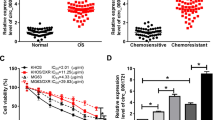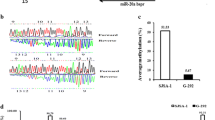Abstract
Purpose
A number of studies have demonstrated that microRNAs play a critical role in osteosarcoma progression, therapy and drug resistance. MicroRNA-202 has proven to be dysregulated in many human cancer studies. This study aimed to explore miR-202 contributions to drug resistance in osteosarcoma.
Methods
miR-202 expression was measured by real-time PCR in patient tissues, cell lines or cells treated with TGF-β1, using siRNA to knock down the expression of Smad2, Smad3 and Smad4. miR-202 mimics, inhibitor and scramble siRNA were transfected into osteosarcoma cells to observe effects on cell apoptosis and drug resistance. Moreover, relationships of miR-202 level with PDCD4 were investigated by luciferase reporter assay, real-time PCR and Western blotting.
Results
We found that miR-202 is overexpressed in osteosarcoma tissues when compared with normal human osteoblasts and TGF-β1 can induce the expression of miR-202. Transfection of miR-202 mimics into osteosarcoma cell lines significantly promotes chemotherapy resistance by targeting PDCD4, a tumor suppressor which is involved in apoptosis. In contrast, transfection of miR-202 inhibitor enhances the drug sensitivity and apoptosis.
Conclusions
This study provides new insights into miRNA-202 in osteosarcoma as a potential molecular target for chemotherapy.




Similar content being viewed by others
References
Cai CK, Zhao GY, Tian LY, Liu L, Yan K, Ma YL, Ji ZW, Li XX, Han K, Gao J, Qiu XC, Fan QY, Yang TT, Ma BA (2012) miR-15a and miR-16-1 downregulate CCND1 and induce apoptosis and cell cycle arrest in osteosarcoma. Oncol Rep 28:1764–1770
Chan XH, Nama S, Gopal F, Rizk P, Ramasamy S, Sundaram G, Ow GS, Ivshina AV, Tanavde V, Haybaeck J, Kuznetsov V, Sampath P (2012) Targeting glioma stem cells by functional inhibition of a prosurvival oncomiR-138 in malignant gliomas. Cell Rep 2:591–602
Chen PY, Qin L, Barnes C, Charisse K, Yi T, Zhang X, Ali R, Medina PP, Yu J, Slack FJ, Anderson DG, Kotelianski V, Wang F, Tellides G, Simons M (2012) FGF regulates TGF-beta signaling and endothelial-to-mesenchymal transition via control of let-7 miRNA expression. Cell Rep 2:1684–1696
Chen X, Bahrami A, Pappo A, Easton J, Dalton J, Hedlund E, Ellison D, Shurtleff S, Wu G, Wei L, Parker M, Rusch M, Nagahawatte P, Wu J, Mao S, Boggs K, Mulder H, Yergeau D, Lu C, Ding L, Edmonson M, Qu C, Wang J, Li Y, Navid F, Daw NC, Mardis ER, Wilson RK, Downing JR, Zhang J, Dyer MA, St. Jude Children’s Research Hospital-Washington University Pediatric Cancer Genome, P (2014a) Recurrent somatic structural variations contribute to tumorigenesis in pediatric osteosarcoma. Cell Rep 7:104–112
Chen Y, Wang SX, Mu R, Luo X, Liu ZS, Liang B, Zhuo HL, Hao XP, Wang Q, Fang DF, Bai ZF, Wang QY, Wang HM, Jin BF, Gong WL, Zhou T, Zhang XM, Xia Q, Li T (2014b) Dysregulation of the miR-324-5p-CUEDC2 axis leads to macrophage dysfunction and is associated with colon cancer. Cell Rep 7:1982–1993
Chen L, Jiang K, Jiang H, Wei P (2014c) miR-155 mediates drug resistance in osteosarcoma cells via inducing autophagy. Exp Ther Med 8:527–532
Chou AJ, Gorlick R (2006) Chemotherapy resistance in osteosarcoma: current challenges and future directions. Expert Rev Anticancer Ther 6:1075–1085
Ferguson WS, Goorin AM (2001) Current treatment of osteosarcoma. Cancer Invest 19:292–315
Franchi A, Arganini L, Baroni G, Calzolari A, Capanna R, Campanacci D, Caldora P, Masi L, Brandi ML, Zampi G (1998) Expression of transforming growth factor beta isoforms in osteosarcoma variants: association of TGF beta 1 with high-grade osteosarcomas. J Pathol 185:284–289
Geller DS, Gorlick R (2010) Osteosarcoma: a review of diagnosis, management, and treatment strategies. Clin Adv Hematol Oncol 8:705–718
Ghosh T, Aprea J, Nardelli J, Engel H, Selinger C, Mombereau C, Lemonnier T, Moutkine I, Schwendimann L, Dori M, Irinopoulou T, Henrion-Caude A, Benecke AG, Arnold SJ, Gressens P, Calegari F, Groszer M (2014) MicroRNAs establish robustness and adaptability of a critical gene network to regulate progenitor fate decisions during cortical neurogenesis. Cell Rep 7:1779–1788
Han C, Liu Y, Wan G, Choi HJ, Zhao L, Ivan C, He X, Sood AK, Zhang X, Lu X (2014) The RNA-binding protein DDX1 promotes primary microRNA maturation and inhibits ovarian tumor progression. Cell Rep 8:1447–1460
Kim K, Vinayagam A, Perrimon N (2014) A rapid genome-wide microRNA screen identifies miR-14 as a modulator of Hedgehog signaling. Cell Rep 7:2066–2077
Li YG, He JH, Yu L, Hang ZP, Li W, Shun WH, Huang GX (2014) microRNA202 suppresses MYCN expression under the control of E2F1 in the neuroblastoma cell line LAN5. Mol Med Rep 9:541–546
Luetke A, Meyers PA, Lewis I, Juergens H (2014) Osteosarcoma treatment—where do we stand? A state of the art review. Cancer Treat Rev 40:523–532
Navid F, Letterio JJ, Yeung CL, Pegtel M, Helman LJ (2000) Autocrine transforming growth factor-beta growth pathway in murine osteosarcoma cell lines associated with inability to affect phosphorylation of retinoblastoma protein. Sarcoma 4:93–102
Song B, Wang Y, Xi Y, Kudo K, Bruheim S, Botchkina GI, Gavin E, Wan Y, Formentini A, Kornmann M, Fodstad O, Ju J (2009) Mechanism of chemoresistance mediated by miR-140 in human osteosarcoma and colon cancer cells. Oncogene 28:4065–4074
Sun Z, Zhang T, Hong H, Liu Q, Zhang H (2014) miR-202 suppresses proliferation and induces apoptosis of osteosarcoma cells by downregulating Gli2. Mol Cell Biochem 397:277–283
Wang Q, Huang Z, Guo W, Ni S, Xiao X, Wang L, Huang D, Tan C, Xu Q, Zha R, Zhang J, Sheng W, He X, Du X (2014) microRNA-202-3p inhibits cell proliferation by targeting ADP-ribosylation factor-like 5A in human colorectal carcinoma. Clin Cancer Res 20:1146–1157
Zhang YK, Wang H, Leng Y, Li ZL, Yang YF, Xiao FJ, Li QF, Chen XQ, Wang LS (2011) Overexpression of microRNA-29b induces apoptosis of multiple myeloma cells through down regulating Mcl-1. Biochem Biophys Res Commun 414:233–239
Zhang D, Shi Z, Li M, Mi J (2014a) Hypoxia-induced miR-424 decreases tumor sensitivity to chemotherapy by inhibiting apoptosis. Cell Death Dis 5:e1301
Zhang Y, Zheng D, Xiong Y, Xue C, Chen G, Yan B, Ye Q (2014b) miR-202 suppresses cell proliferation in human hepatocellular carcinoma by downregulating LRP6 post-transcriptionally. FEBS Lett 588:1913–1920
Author information
Authors and Affiliations
Corresponding author
Ethics declarations
Conflict of interest
The authors declare no conflict of interest.
Ethical standards
This article does not contain any studies with animals performed by any of the authors. All the patients were gave their informed consent prior to their inclusion in the study.
Rights and permissions
About this article
Cite this article
Lin, Z., Song, D., Wei, H. et al. TGF-β1-induced miR-202 mediates drug resistance by inhibiting apoptosis in human osteosarcoma. J Cancer Res Clin Oncol 142, 239–246 (2016). https://doi.org/10.1007/s00432-015-2028-9
Received:
Accepted:
Published:
Issue Date:
DOI: https://doi.org/10.1007/s00432-015-2028-9




